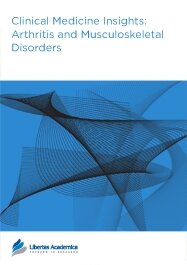

Publication Date: 20 May 2010
Type: Original Research
Journal: Clinical Medicine Insights: Arthritis and Musculoskeletal Disorders
Citation: Clinical Medicine Insights: Arthritis and Musculoskeletal Disorders 2010:3 25-31
doi: 10.4137/CMAMD.S4935

Objective: Rheumatoid arthritis (RA) differs depending on the age of disease onset. The differences between EORA and YORA are important because they have clinical and therapeutic implications.
Method: 1185 patients were ranked after classification according to age at onset of the disease into YORA I (16–40 years), YORA II (41–60 years) and EORA .60 years. All patients groups were compared, based on disease duration, disease activity, severity parameters and drug history.
Results: YORA I included 298 patients, 28.85% were males, with mean age of 29.4 ± 6 years and disease duration 4 ± 3.3 y, YORA II included 539 patients, 33.77% males, age 49.7 ± 6.1 y and disease duration 6.5 ± 5.6 y. EORA included 348 RA patients 40.5% males, age 67.1 ± 6.6 y, disease duration 9.95 ± 7.2 y. Activity was increased in EORA compared to YORA I and YORA II, while severity decreased in EORA. ESR, CRP and degree of anemia were higher in EORA. RF titer was higher in YORA. Small joints of the hands and feet were more involved in YORA, while, large joints in EORA. Rheumatoid nodules were increased in YORA I than EORA P = 0.04. Polymyalgia rheumatica was exclusively present in EORA group 25 patients 7.2%. Methotrexate was used in both YORA and EORA, with a higher mean of dosage in YORA than EORA. Multiple DMARDs in EORA was 57.9%, and biologics in 0.8% was which was significantly lower compared with YORA I, 86.3% and 1.7%, with P = 0.001.
Conclusion: EORA has more active and less disabling and affects more males than YORA. The use of biologic therapy and combination DMARD therapy was less in EORA.
PDF (531.80 KB PDF FORMAT)
RIS citation (ENDNOTE, REFERENCE MANAGER, PROCITE, REFWORKS)
BibTex citation (BIBDESK, LATEX)
XML
PMC HTML

The staff of Libertas Academica have been exceptionally easy to work with. They continually keep authors updated and are responsive to all requests. They were also very flexible to work with when I had some challenges from my end as an author. Article reviews were received very promptly and were constructive and helpful for improving the manuscript. The online submission system was easy to use and provided clear guidance on what was needed. I highly ...

All authors are surveyed after their articles are published. Authors are asked to rate their experience in a variety of areas, and their responses help us to monitor our performance. Presented here are their responses in some key areas. No 'poor' or 'very poor' responses were received; these are represented in the 'other' category.See Our Results
Copyright © 2014 Libertas Academica Ltd (except open access articles and accompanying metadata and supplementary files.)
Facebook Google+ Twitter
Pinterest Tumblr YouTube